mirror HONDA CIVIC 2022 Owners Manual
[x] Cancel search | Manufacturer: HONDA, Model Year: 2022, Model line: CIVIC, Model: HONDA CIVIC 2022Pages: 700, PDF Size: 13.98 MB
Page 8 of 700
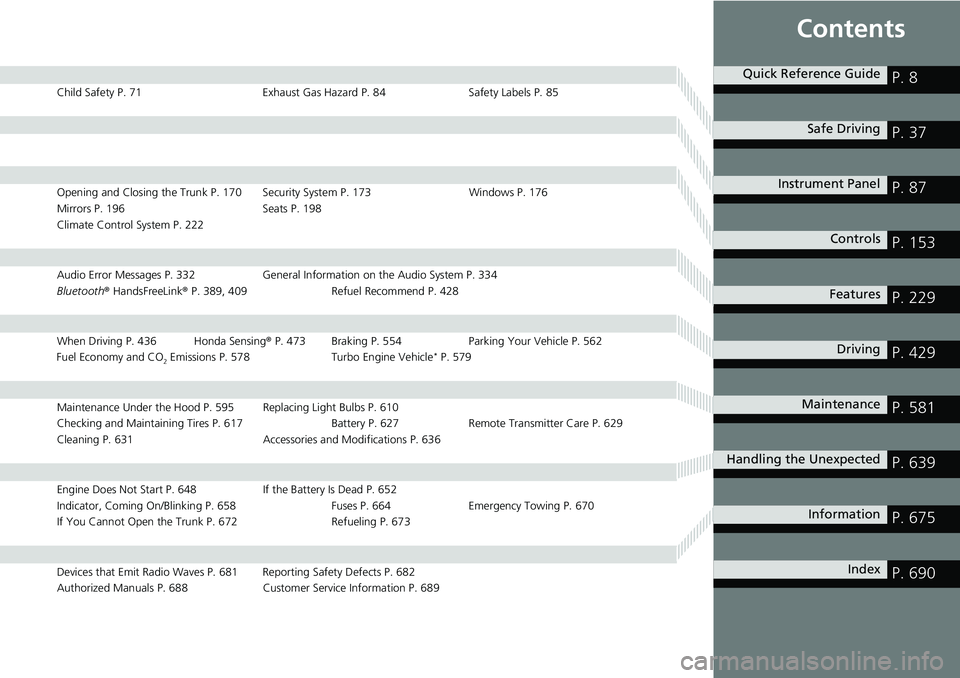
Contents
Child Safety P. 71Exhaust Gas Hazard P. 84Safety Labels P. 85
Opening and Closing the Trunk P. 170 Security System P. 173 Windows P. 176
Mirrors P. 196 Seats P. 198
Climate Control System P. 222
Audio Error Messages P. 332 General Information on the Audio System P. 334
Bluetooth ® HandsFreeLink ® P. 389, 409 Refuel Recommend P. 428
When Driving P. 436 Honda Sensing ® P. 473 Braking P. 554 Parki ng Your Vehicle P. 562
Fuel Economy and CO
2 Emissions P. 578 Turbo Engine Vehicle* P. 579
Maintenance Under the Hood P. 595 Replacing Light Bulbs P. 610
Checking and Maintaining Tires P. 617 Batt ery P. 627 Remote Transmitter Care P. 629
Cleaning P. 631 Accessories and Modifications P. 636
Engine Does Not Start P. 648 If the Battery Is Dead P. 652
Indicator, Coming On/Blinking P. 658 Fuses P. 664Emergency Towing P. 670
If You Cannot Open the Trunk P. 672 Refueling P. 673
Devices that Emit Radio Waves P. 681 Reporting Safety Defects P. 682
Authorized Manuals P. 688 Customer Service Information P. 689
Quick Reference GuideP. 8
Safe DrivingP. 37
Instrument PanelP. 87
ControlsP. 153
FeaturesP. 229
DrivingP. 429
MaintenanceP. 581
Handling the UnexpectedP. 639
InformationP. 675
IndexP. 690
Page 9 of 700

8
Quick Reference Guide
Quick Reference Guide
Visual Index
❚Climate Control System (P 222)
❚Rear Defogger (P 192)
❚Heated Door Mirror Button* (P 192)
❚Hazard Warning Button
❚Passenger Airbag Off Indicator
(P 68)
❚Audio System (P 230)
❚Navigation System*
() See Navigation System Manual
❚Front Seat Heater Buttons* (P 220)
❚ (Vehicle Stability AssistTM (VSA ®) System OFF) Button (P 460)
❚Safety Support Switch (P471, 480, 540)
❚Parking Sensor System Button* (P565 )
❚Brightness Control (P 193, 194)
❚System Indicators (P 88)
❚Gauges (P 109)
❚Driver Information Interface (P 113, 135, 138)
❚ENGINE START/STOP Button (P 180)
Page 11 of 700
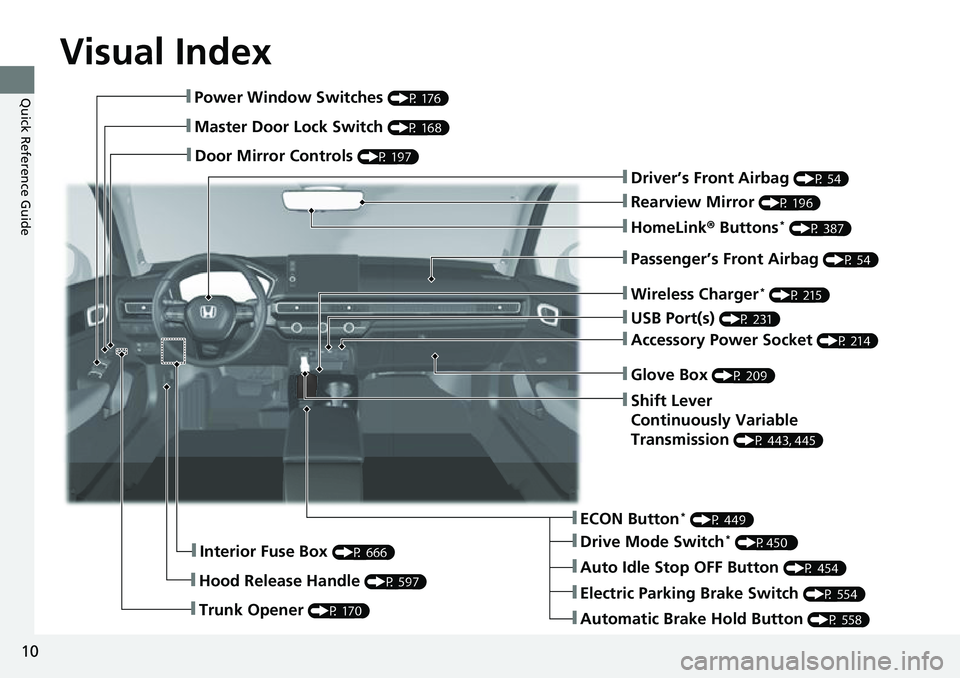
Visual Index
10
Quick Reference Guide❚Power Window Switches (P 176)
❚Master Door Lock Switch (P 168)
❚Door Mirror Controls (P 197)
❚Trunk Opener (P 170)
❚Interior Fuse Box (P 666)
❚Hood Release Handle (P 597)
❚Driver’s Front Airbag (P 54)
❚Rearview Mirror (P 196)
❚HomeLink® Buttons* (P 387)
❚Passenger’s Front Airbag (P 54)
❚Wireless Charger* (P 215)
❚USB Port(s) (P 231)
❚ECON Button* (P 449)
❚Electric Parking Brake Switch (P 554)
❚Drive Mode Switch* (P450 )
❚Accessory Power Socket (P 214)
❚Glove Box (P 209)
❚Shift Lever
Continuously Variable
Transmission
(P 443, 445)
❚Auto Idle Stop OFF Button (P 454)
❚Automatic Brake Hold Button (P 558)
Page 12 of 700
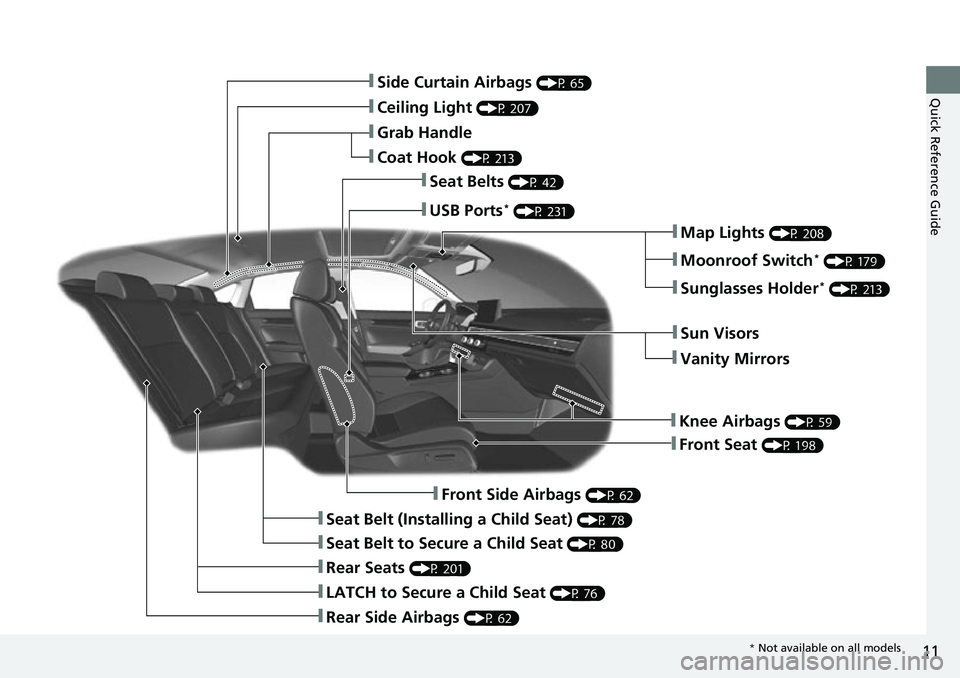
11
Quick Reference Guide❚Side Curtain Airbags (P 65)
❚Ceiling Light (P 207)
❚Grab Handle
❚Coat Hook (P 213)
❚Seat Belts (P 42)
❚Map Lights (P 208)
❚Moonroof Switch* (P 179)
❚Sunglasses Holder* (P 213)
❚Sun Visors
❚Vanity Mirrors
❚Front Side Airbags (P 62)
❚Seat Belt (Installing a Child Seat) (P 78)
❚Seat Belt to Secure a Child Seat (P 80)
❚LATCH to Secure a Child Seat (P 76)
❚Rear Seats (P 201)
❚USB Ports* (P 231)
❚Rear Side Airbags (P 62)
❚Knee Airbags (P 59)
❚Front Seat (P 198)
* Not available on all models
Page 13 of 700
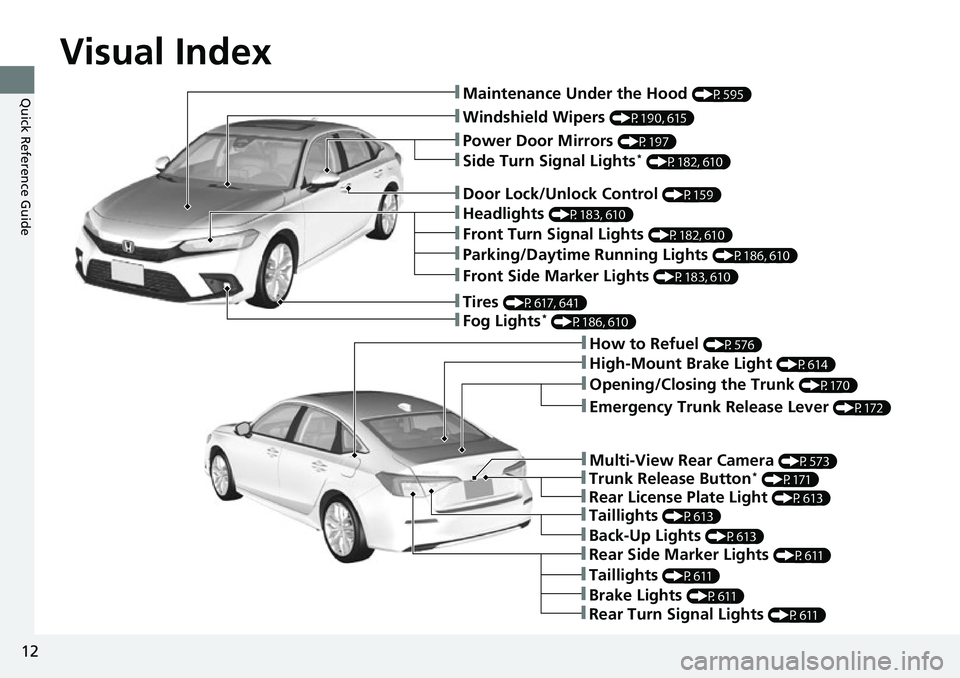
Visual Index
12
Quick Reference Guide❚Maintenance Under the Hood (P595)
❚Windshield Wipers (P190, 615)
❚Tires (P617, 641)
❚Fog Lights* (P186, 610)
❚Power Door Mirrors (P197)
❚How to Refuel (P576)
❚High-Mount Brake Light (P614)
❚Emergency Trunk Release Lever (P172)
❚Opening/Closing the Trunk (P170)
❚Door Lock/Unlock Control (P159)
❚Side Turn Signal Lights* (P182, 610)
❚Headlights (P183, 610)
❚Front Turn Signal Lights (P182, 610)
❚Front Side Marker Lights (P183, 610)
❚Taillights (P613)
❚Brake Lights (P611)
❚Rear Turn Signal Lights (P611)
❚Rear Side Marker Lights (P611)
❚Taillights (P611)
❚Parking/Daytime Running Lights (P186, 610)
❚Multi-View Rear Camera (P573)
❚Trunk Release Button* (P171)
❚Rear License Plate Light (P613)
❚Back-Up Lights (P613)
Page 16 of 700
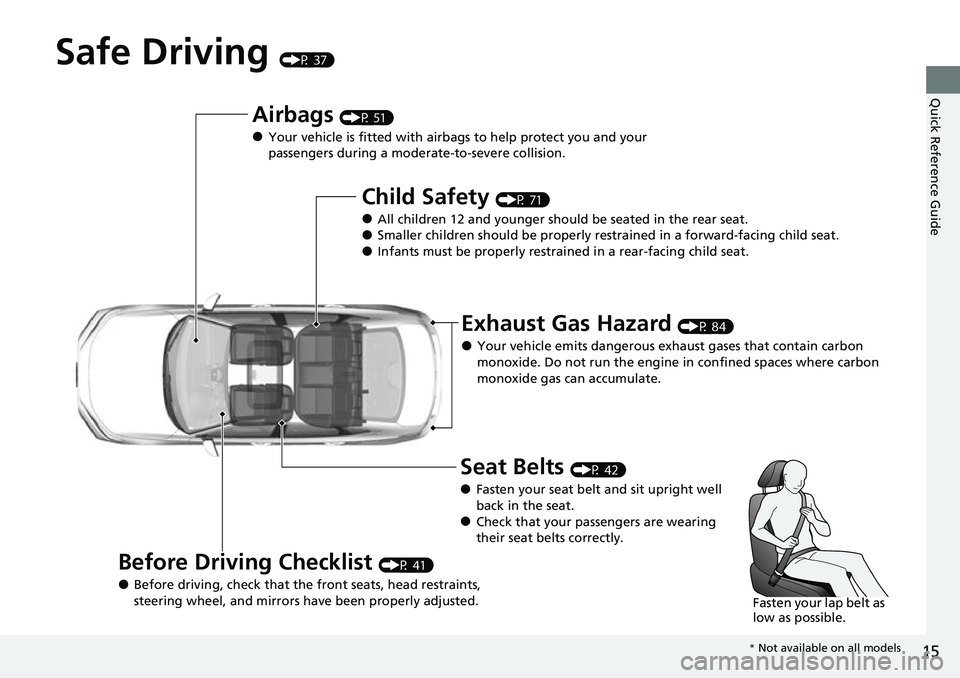
15
Quick Reference Guide
Safe Driving (P 37)
Airbags (P 51)
●Your vehicle is fitted with airbags to help protect you and your
passengers during a moderate-to-severe collision.
Child Safety (P 71)
●All children 12 and younger should be seated in the rear seat.●Smaller children should be properly restrained in a forward-facing child seat.●Infants must be properly restrained in a rear-facing child seat.
Exhaust Gas Hazard (P 84)
●Your vehicle emits dangerous exhaust gases that contain carbon
monoxide. Do not run the engine in confined spaces where carbon
monoxide gas can accumulate.
Before Driving Checklist (P 41)
●Before driving, check that the front seats, head restraints,
steering wheel, and mirrors have been properly adjusted.
Seat Belts (P 42)
●Fasten your seat belt and sit upright well
back in the seat.
●Check that your passengers are wearing
their seat belts correctly.
Fasten your lap belt as
low as possible.
* Not available on all models
Page 21 of 700
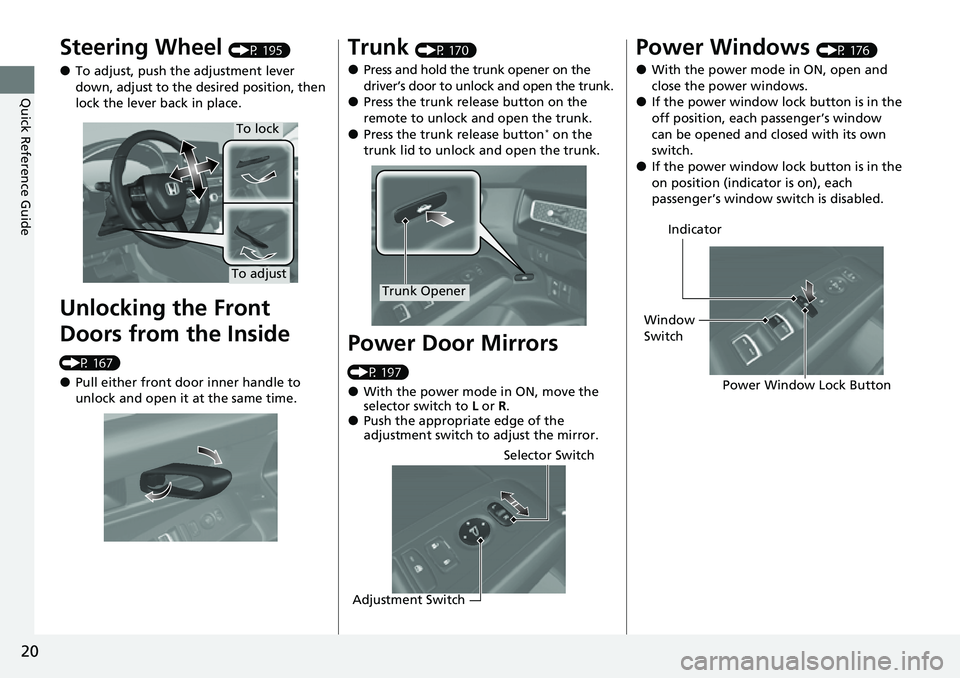
20
Quick Reference Guide
Steering Wheel (P 195)
●To adjust, push the adjustment lever
down, adjust to the desired position, then
lock the lever back in place.
Unlocking the Front
Doors from the Inside
(P 167)
●Pull either front door inner handle to
unlock and open it at the same time.
To adjust
To lock
Trunk (P 170)
●Press and hold the trunk opener on the
driver’s door to unlock and open the trunk.
●Press the trunk release button on the
remote to unlock and open the trunk.
●Press the trunk release button* on the
trunk lid to unlock and open the trunk.
Power Door Mirrors
(P 197)
●With the power mode in ON, move the
selector switch to L or R.
●Push the appropriate edge of the
adjustment switch to adjust the mirror.
Trunk Opener
Selector Switch
Adjustment Switch
Power Windows (P 176)
●With the power mode in ON, open and
close the power windows.
●If the power window lock button is in the
off position, each passenger’s window
can be opened and closed with its own
switch.
●If the power window lock button is in the
on position (indicator is on), each
passenger’s window switch is disabled.
Power Window Lock Button
Window
Switch Indicator
Page 30 of 700
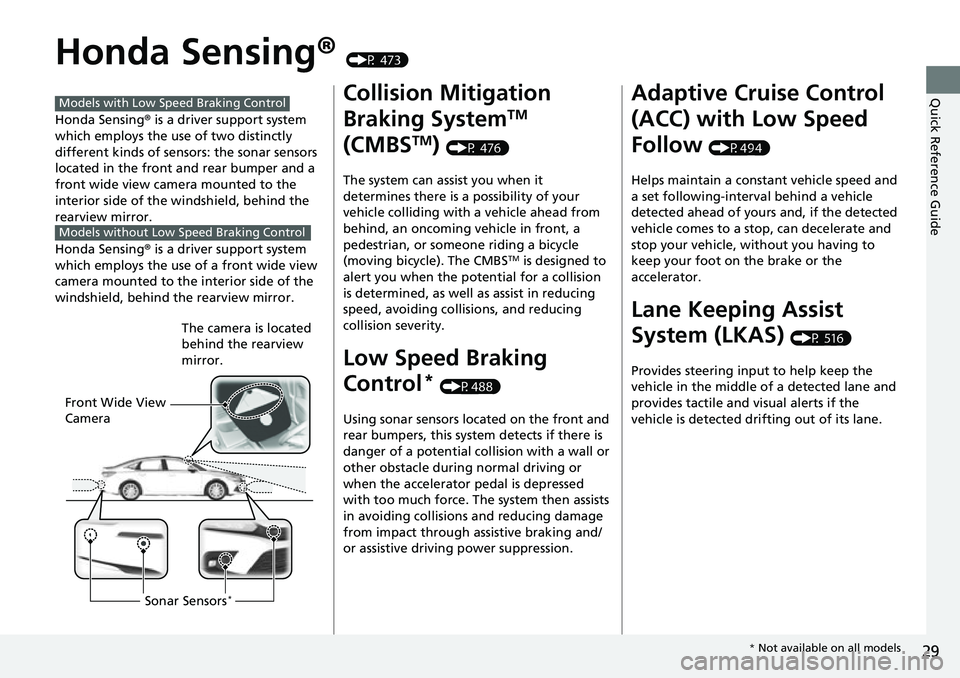
29
Quick Reference Guide
Honda Sensing® (P 473)
Honda Sensing ® is a driver support system
which employs the use of two distinctly
different kinds of sens ors: the sonar sensors
located in the front and rear bumper and a
front wide view camera mounted to the
interior side of the windshield, behind the
rearview mirror.
Honda Sensing ® is a driver support system
which employs the use of a front wide view
camera mounted to the interior side of the
windshield, behind the rearview mirror.
Models with Low Speed Braking Control
Models without Low Speed Braking Control
Front Wide View
Camera The camera is located
behind the rearview
mirror.
Sonar Sensors*
Collision Mitigation
Braking System
TM
(CMBS
TM) (P 476)
The system can assist you when it
determines there is a possibility of your
vehicle colliding with a vehicle ahead from
behind, an oncoming vehicle in front, a
pedestrian, or someone riding a bicycle
(moving bicycle). The CMBS
TM is designed to
alert you when the potential for a collision
is determined, as well as assist in reducing
speed, avoiding collisions, and reducing
collision severity.
Low Speed Braking
Control
* (P488)
Using sonar sensors located on the front and
rear bumpers, this system detects if there is
danger of a potential collision with a wall or
other obstacle during normal driving or
when the accelerator pedal is depressed
with too much force. The system then assists
in avoiding collisions and reducing damage
from impact through assistive braking and/
or assistive driving power suppression.
Adaptive Cruise Control
(ACC) with Low Speed
Follow
(P494)
Helps maintain a constant vehicle speed and
a set following-interval behind a vehicle
detected ahead of yours and, if the detected
vehicle comes to a stop, can decelerate and
stop your vehicle, without you having to
keep your foot on the brake or the
accelerator.
Lane Keeping Assist
System (LKAS)
(P 516)
Provides steering input to help keep the
vehicle in the middle of a detected lane and
provides tactile and visual alerts if the
vehicle is detected drifting out of its lane.
* Not available on all models
Page 154 of 700
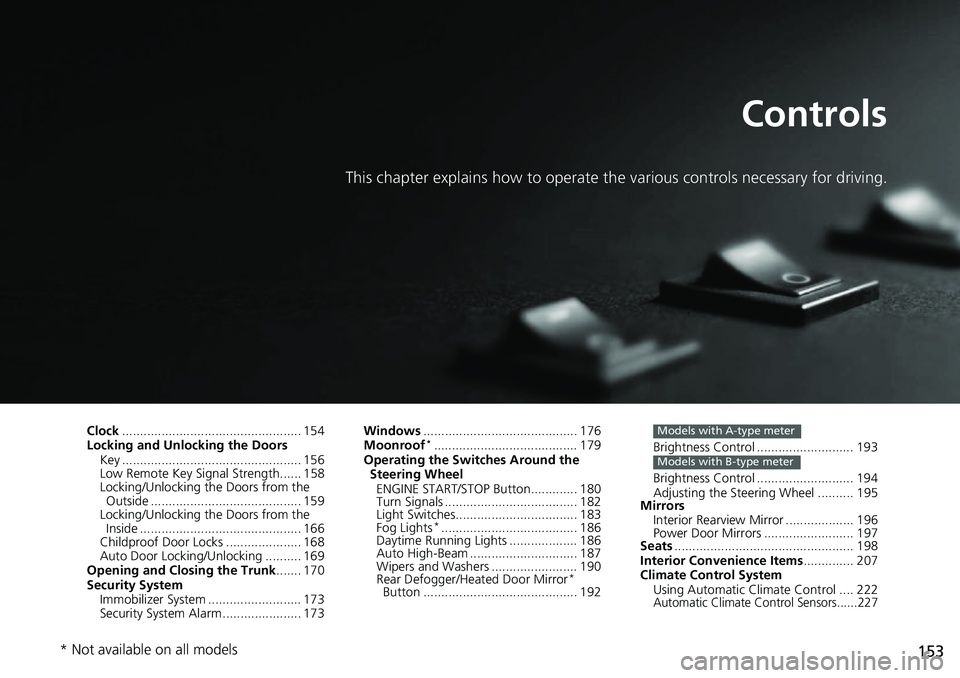
153
Controls
This chapter explains how to operate the various controls necessary for driving.
Clock.................................................. 154
Locking and Unlocking the Doors Key .................................................. 156
Low Remote Key Signal Strength...... 158
Locking/Unlocking the Doors from the Outside .......................................... 159
Locking/Unlocking the Doors from the
Inside ............................................. 166
Childproof Door Locks ..................... 168
Auto Door Locking/Unlocking .......... 169
Opening and Closing the Trunk ....... 170
Security System Immobilizer System .......................... 173
Security System Alarm ...................... 173 Windows
........................................... 176
Moonroof*........................................ 179
Operating the Switches Around the Steering Wheel ENGINE START/STOP Button............. 180
Turn Signals ..................................... 182
Light Switches.................................. 183
Fog Lights
*...................................... 186
Daytime Running Lights ................... 186
Auto High-Beam .............................. 187
Wipers and Washers ........................ 190
Rear Defogger/Heat ed Door Mirror
*
Button ........................................... 192 Brightness Control ........................... 193
Brightness Control ........................... 194
Adjusting the Steering Wheel .......... 195
Mirrors
Interior Rearview Mirror ................... 196
Power Door Mirrors ......................... 197
Seats .................................................. 198
Interior Convenience Items .............. 207
Climate Control System Using Automatic Climate Control .... 222
Automatic Climate Control Sensors......227
Models with A-type meter
Models with B-type meter
* Not available on all models
Page 189 of 700
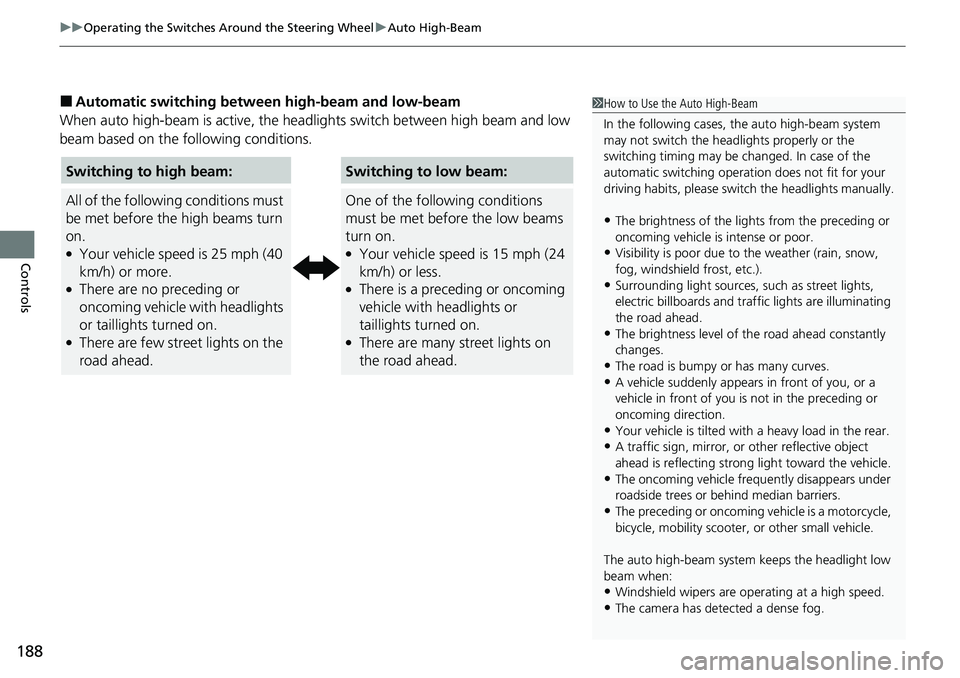
uuOperating the Switches Around the Steering Wheel uAuto High-Beam
188
Controls
■Automatic switching between high-beam and low-beam
When auto high-beam is ac tive, the headlights switch between high beam and low
beam based on the following conditions.1 How to Use the Auto High-Beam
In the following cases, th e auto high-beam system
may not switch the head lights properly or the
switching timing may be ch anged. In case of the
automatic switching operati on does not fit for your
driving habits, please swit ch the headlights manually.
•The brightness of the lights from the preceding or
oncoming vehicle is intense or poor.
•Visibility is poor due to the weather (rain, snow,
fog, windshield frost, etc.).
•Surrounding light sources, such as street lights,
electric billboards and traf fic lights are illuminating
the road ahead.
•The brightness level of th e road ahead constantly
changes.
•The road is bumpy or has many curves.•A vehicle suddenly appears in front of you, or a
vehicle in front of you is not in the preceding or
oncoming direction.
•Your vehicle is tilted with a heavy load in the rear.•A traffic sign, mirror, or other reflective object
ahead is reflecting strong light toward the vehicle.
•The oncoming vehicle freq uently disappears under
roadside trees or be hind median barriers.
•The preceding or oncoming vehicle is a motorcycle,
bicycle, mobility scooter, or other small vehicle.
The auto high-beam system keeps the headlight low
beam when:
•Windshield wipers are op erating at a high speed.
•The camera has detected a dense fog.
Switching to high beam:
All of the following conditions must
be met before the high beams turn
on.
●Your vehicle speed is 25 mph (40
km/h) or more.
●There are no preceding or
oncoming vehicle with headlights
or taillights turned on.
●There are few street lights on the
road ahead.
Switching to low beam:
One of the following conditions
must be met before the low beams
turn on.
●Your vehicle speed is 15 mph (24
km/h) or less.
●There is a preceding or oncoming
vehicle with headlights or
taillights turned on.
●There are many street lights on
the road ahead.